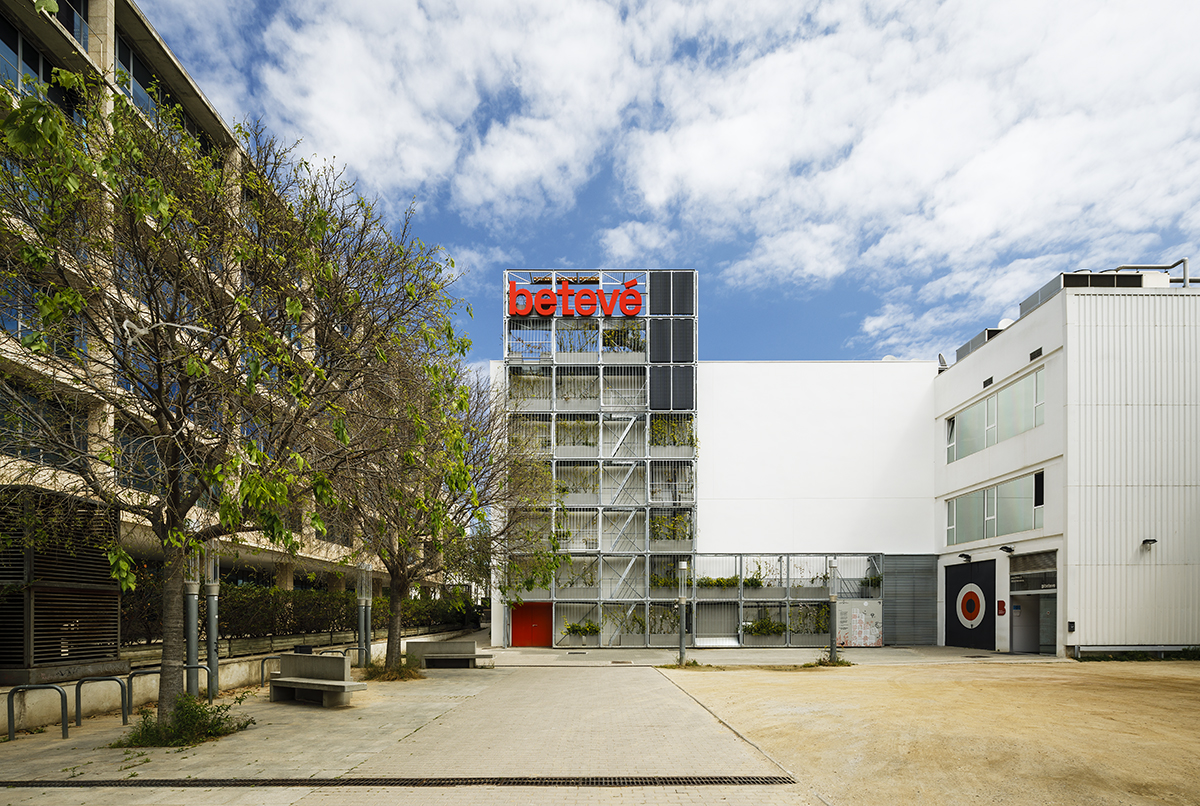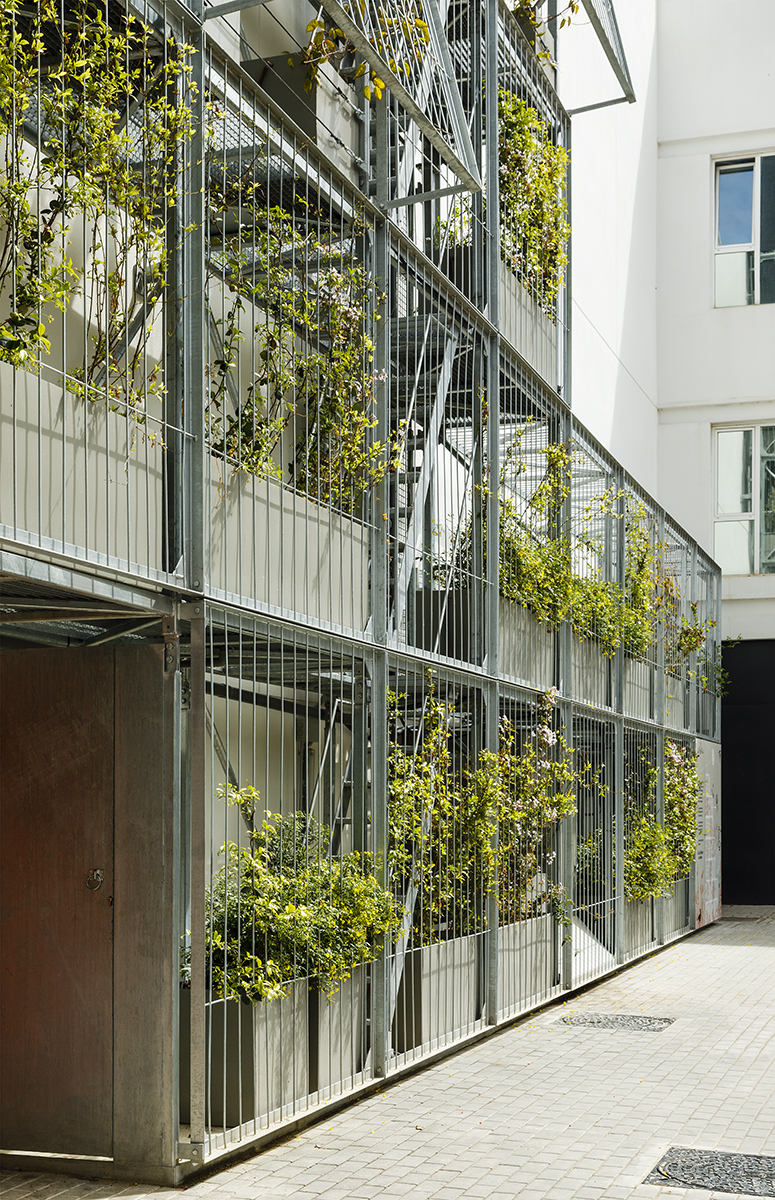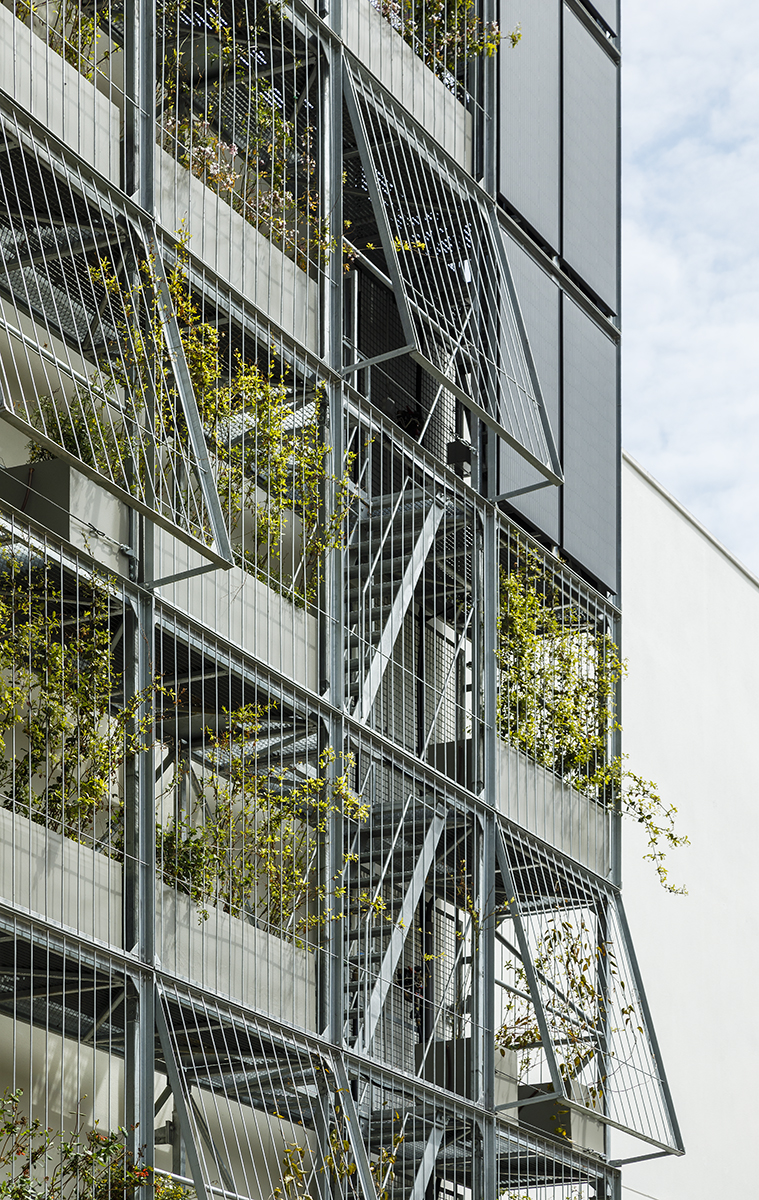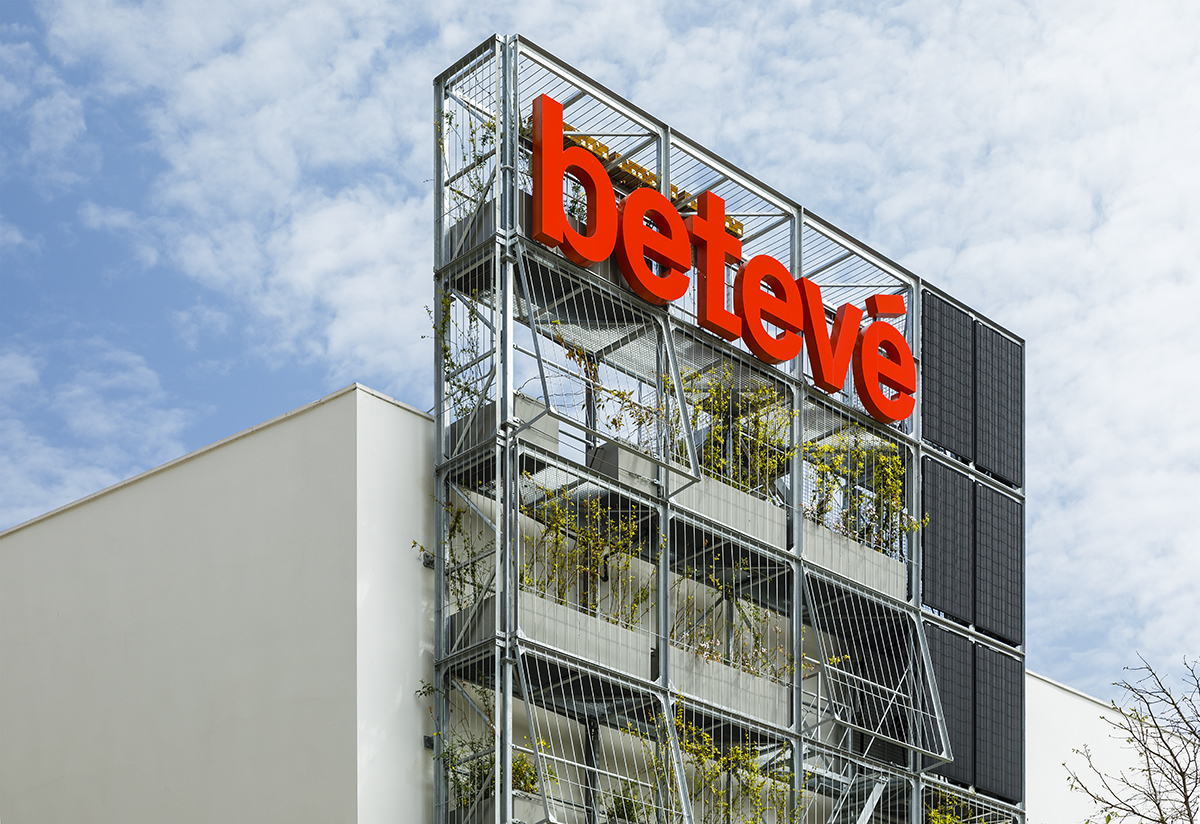Beteve’s modular vertical garden is a pilot test on a system for greening party walls in urban spaces by creating self-sufficient plant façades.
A steel structure is designed to be completely covered with lines of flower boxes containing species of plants, thereby creating a new green façade.
The system is replicable, industrialised, adaptable to several geometries, self-sufficient in water and energy resources and low maintenance.
The Institute of Urban Landscape at Barcelona City Council has a long history in renovating party walls and improving the urban landscape. One of the strategies we use is that of creating vertical gardens in public spaces.
This vertical garden in the Beteve media company’s building is a pilot test on a modular system designed for turning party walls into green façades.
The aims of the design are as follows: greening, industrialising, energy and water autonomy, formal adaptability, minimum maintenance and versatility of uses.
Greening
Lines of flower boxes are arranged in various levels, enabling plants to gradually colonise the entire façade. Bird’s and bat’s nests have been put up in the garden, creating a small biodiversity node.
Industrialisation and ease of assembly
The system is made up of a light self-supporting structure of 2.2 x 2.2 x 1 m easy-to-assemble modules that can be combined in several geometries. Being easy to dismantle means it can be reused in other locations.
Energy and water autonomy
It has an automated irrigation system using rainwater collected from the building’s roof. A photovoltaic panel generates sufficient electricity for its irrigation facility to function.
Formal adaptability
The modular system enables numerous combinations of height and length. In this case it was about turning the Beteve building’s blind façade into a green façade that opens to the square opposite.
Minimum maintenance and versatility of uses
The system’s versatility has enabled it to integrate a corporate logo, photovoltaic panels and a space for audio-visual screenings into the garden as well as a new viewpoint in the upper part. Its vertical accessibility, autonomy and automation reduce the need for maintenance work.
Please highlight how the project can be exemplary in this context
1.Making a positive environmental impact on the urban surroundings with the creation of a vertical garden.
-
- Biodiversity is being increased in the surrounding urban environment with the installation of nests for protected species of birds (apus apus, tachymarptis melba) and bats.
- Plant species are used that are well adapted to Barcelona’s climate and environmental conditions. The more plants there are in urban environments, the cleaner the air.
- The system can be used as an urban allotment for local food production.
2. Energy and water self-sufficiency.
-
- Zero water consumption: rain water is collected from the Beteve building’s roof and is redirected to a tank integrated into the garden. The water is used for supplying the garden’s automated irrigation system.
- Electricity production from the photovoltaic solar panel: this generates sufficient electricity to supply the garden’s own consumption (service lighting, controllers, automatised irrigation facility) and the building that the garden is installed on.
3. Improved energy balance in the building where it is installed
-
- The modular garden provides a new active façade on the existing building, enabling electricity to be generated with the new photovoltaic panel.
- It reduces the façade’s exposure to the sun, cutting down the building’s cooling consumption and improving its acoustic insulation.
- The garden helps to improve the building’s water cycle by using rainwater which has never been used until now.
4. Lengthening of life cycle.
-
- Industrialised and modular construction that can be dismantled and later reused in the future at other locations, thereby lengthening its useful life.
- Reduced maintenance: use of suitable and long-life materials for public spaces reducing the impact of life-cycle actions.
- Autonomous and easy-access vertical garden that helps to reduce the garden’s need for auxiliary resources, staff and maintenance work.
Please highlight how the project can be exemplary in this context
Beteve’s vertical modular garden is a pilot test on a system for use on party walls to improve Barcelona’s urban landscape. Barcelona has over 6,000 party walls in plain view in public spaces. Many of these are located in urban environments with few plants and little space for creating new green spaces in their nearby physical surroundings.
It is in this context that the modular vertical garden system we are presenting is designed as a tool for renovating these unfinished façades while creating new vertical green spaces. It offers various configurations in terms of length and height so it can be adapted to various party walls and façades.
In the specific case of this project in the Beteve building, the construction and aesthetic criteria are as follows:
-
- Renovation of the existing façade to generate a new one that gives visibility and a distinctive image to the Beteve audio-visual media company.
- Generation, with the garden's modular system, of a façade composition that integrates different elements: corporate logo, viewpoint, space for screenings, photovoltaic panels, bird’s nests and noticeboard.
- The resulting façade has turned a white, monotonous wall into a living, changing, symbolic and representative façade, transforming a place lacking urban quality into a representative public space.
Please highlight how the project can be exemplary in this context
The project was developed by the Institute of Urban Landscape together with the following departments at Barcelona City Council: The Energy Agency, the Department of Parks and Gardens, the Beteve communication and television channel, also under municipal management.
The initiative is enshrined in the overall city goal of increasing green spaces.
As with all public works in Barcelona’s public spaces, the approval of the project included a public-scrutiny stage and its design meets the requirements for public works in the city’s public spaces.
Social uses: urban allotment
Social education
Panel, outreach activity
Once implemented, the initiative will be publicised in “Barcelona Architecture Week” with guided tours for city residents and private organisations interested in launching similar initiatives in the rest of the city.
Please highlight how this approach can be exemplary
The project is a clear example of combining three aspects:
-
- Sustainability: self-sufficient vertical garden, producing energy, improving biodiversity and enabling dismantling and future re-installation.
-
- Aesthetics: the modular vertical garden system project enables the regeneration of unfinished urban façades, such as party and residual walls, through the creation of easy-maintenance plant façades. It’s an urban-regeneration tool. It can be installed in any type of environment: industrial, residential, tertiary and so on.
-
- Inclusion: the system helps to increase biodiversity and the presence of nature in highly anthropic urban public spaces for all citizens to enjoy. It has the potential to adapt to more participatory uses such as urban allotments and consumer cooperatives.
These three aspects are realised physically in Beteve’s modular vertical garden and are replicable in many places in the city.
A year after its construction, the vertical garden's incorporation into the space in Plaça Tisner, in the Beteve building, has led to a greater presence of pedestrians and workers from businesses around the public space it is located in, boosting the square's status as a place for spending time in and enjoying.
Within a 3 to 4 year period, the garden’s plants are expected to reach full growth and volume and achieve their full environmental impact and biodiversity, thus achieving their established targets.
Its self-sufficiency with regard to water and electricity resources was confirmed during its first year, having operated solely with collected rainwater and electricity generated by the photovoltaic panel.
The cost of maintaining the greenery was reduced by 60% and has been simplified in comparison to other vertical garden solutions.
Please also explain the benefits that derived from their involvement.
The Municipal Institute of Urban Landscape has over 30 years’ experience acting on buildings constructed with the involvement of and in collaboration with their residents and housing associations.
The design process of façade and party-wall renovation and greening projects such as this includes ongoing communication with and participation of residents and owners. This is how they carry out their initiatives out and get residents and owners involved in the maintenance of their façades, as an element that is not just theirs but also the community's.
This pilot test has included the experiences and knowledge gathered from all the previous initiatives, so a system can be designed that can be applied not just in housing blocks but in other types of buildings too and which responds to the requests citizens make in every initiative we carry out, such as:
-
- Possibility of making vertical gardens compatible with the creation of new openings in façades.
- Designing a self-supporting structure that doesn't affect the existing building.
- Designing strategies for making gardens self-sufficient and reducing the amount of maintenance residents have to carry out. Includes own public highway access
- Possibility of using rainwater from the roof.
- Possibility of public and private management and maintenance.
- Reduced work time and minimal inconvenience to residents.
In the specific case we're presenting, as a pilot test, this is a workplace building. Representatives of the workers have been mediators and we have incorporated their requests and concerns into the project. They have been very receptive and positive in their acceptance of the garden. Consideration is also being given, following this project, to turning the building’s roof into a green roof.
The project is an example of an urban local-scale initiative for greening built-up urban spaces and existing buildings.
It is helping to bring us closer to our overall goals such as:
-
- Integrating nature into dense urban environments to encourage its presence and relationship with residents.
- Reducing over-heating in the city through increased greened surfaces in built-up urban areas.
- Improving the city's behaviour regarding water resources by promoting the use of rainwater.
- Encouraging the presence of wildlife in urban habitats.
Vertical gardens in the city’s public spaces represent a new strategy that has so far been confined to very occasional initiatives associated mostly with private buildings (corporate offices, hotel lobbies, museums etc.)
High maintenance costs have prevented the greening of existing façades from becoming a solution that is widely used by public organisations in the urban regeneration of cities.
This modular system enables the creation of easy-maintenance modular vertical gardens that make it possible for degraded façades and party walls to be converted into genuine biodiversity hubs.
Densely populated Mediterranean cities such as Barcelona typically have compact urban areas with little in the way of nature in their surroundings. This system can help to introduce nature to these places as a “green infrastructure” budgetary item with affordable investment and maintenance costs and high environmental and landscape benefits for the urban environment it is located in.
Please provide clear documentation, communication of methodology and principles in this context.
The project is the result of years of work on vertical greening. The system includes learning experiences with real initiatives implemented over the last 20 years in Barcelona with various strategies.
One of the main goals of this project, since the very beginning, has been its replicability. Barcelona alone has a potential of some 350 locations with party walls looking onto public spaces.
The system is versatile and enables adaptation to numerous physical environments and can also be applied on industrial building façades, infrastructures and so on. Its ease of construction enables it to be installed in narrow streets and squares and on self-supporting façades of varying heights etc., (up to a maximum of 16 metres) and lengths, taking up a minimum amount of public space along a mere one-metre wide strip
Garden management has numerous possibilities, both public and private, and in cooperative or resident-association formats as well as other possible uses, such as urban allotments.
Barcelona’s tradition as a testing ground for ideas in designing public spaces has turned the city into an international benchmark. There are ongoing initiatives for promoting and transferring knowledge to other public authorities in other cities. In addition, we at the Institute of Urban Landscape offer advice to city residents, public and private organisations interested in urban renovation in general and in initiatives for reforming party walls with greening systems such as this.





@Barcelona City Council, Institute of Urban Landscape , 2021
Content licensed to the European Union.